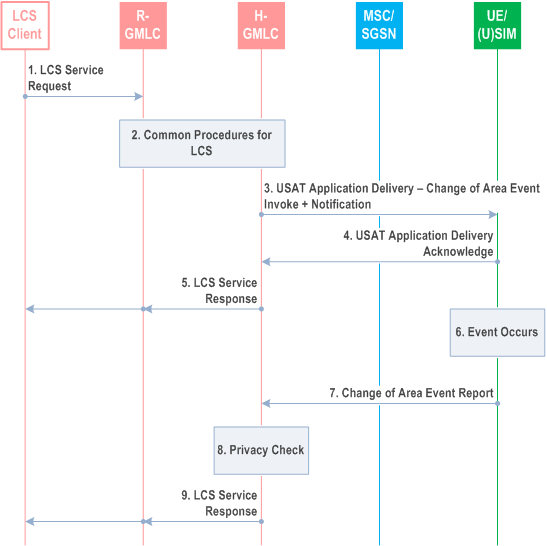Content for TS 23.271 Word version: 18.0.0
1…
5…
6…
6.2…
7…
8…
9…
9.1.1A…
9.1.2…
9.1.5…
9.1.6…
9.1.8…
9.1.9…
9.1.12…
9.1.13…
9.1.15…
9.1.19…
9.2…
9.2.2…
9.2.3…
9.3…
9.4…
9.5…
9.6…
10…
11…
A…
B…
E
F…
F Mechanism for performing Change of Area Event Detection
G Defined Service Types and numbering
$ Change history
F Mechanism for performing Change of Area Event Detection |R6| p. 185
As described in clause 9.1.9 that there may be alternative mechanisms to transfer the deferred MT-LR with Area Event request to the UE. This Annex illustrates one mechanism. In this mechanism a Short Message Service (SMS) is used to transfer, to the UE/(U)SIM, the Area event detection request via an (U)SIM Application Toolkit application.
F.1 (U)SIM Application Toolkit (USAT) Based Solution p. 185
In this (U)SAT based solution, the area event detection mechanism relies on the proactive control of the UE by the (U)SIM using the (U)SAT commands controlled by a specific Change of Area Deferred Location application. Figure F.1 illustrates one possible method for downloading a change of area event application to the UE, but does not detail the operation of the application. The details of the application is outside the scope of this specification. Further information about the possible (U)SAT commands, can be found from TS 31.111.
The following procedure (shown in Figure F.1) replaces Figure 9.6d in clause 9.1.9.

Step 1.
H-GMLC may be the origination point of the SMS-DELIVER and the USAT Application messages.
This step is the same as step 1 in clause 9.1.9.
Step 2.
This step is similar to step 2 in clause 9.1.9, except the LCS Service Request does not reach the V-GMLC. Also the H-GMLC may request a translation of geographic shape to network identities from a GMLC in the network serving the target UE.
Step 3.
Information about the event, the (U)SAT application, that shall trigger the sending of the Location Report shall be sent to the UE/(U)SIM. If privacy action (notification and/or verification) was requested as a result of the privacy check, the H-GMLC shall also include the required action to the UE/(U)SIM. If notification/verification is required, the request shall indicate the identity of the LCS client, the Requestor Identity (if available), and the reference number. The mechanism by which the trigger detection is performed via (U)SAT application may be operator dependent. However, the (U)SAT Application shall contain the following information: reference number, H-GMLC address, validity period of request, and the area definition (of the target area).
Step 4.
If privacy verification was requested, the UE/(U)SIM indicates to its user whether the location request will be allowed or not allowed in the absence of a response and waits for the user to grant or deny permission. If privacy verification was requested and the user grants permission, the USAT Application shall be installed and the UE/(U)SIM then returns an acknowledgement to the H-GMLC indicating permission is granted and (U)SAT application is successfully installed. If the UE user does not respond after a predetermined time period (and the request is not allowed in the absence of a response) or denies permission, the UE/(U)SIM shall infer a "no response" condition, the USAT Application is not installed, an appropriate error response is returned to the GMLC/LCS Client and the remaining steps are skipped. Otherwise the UE/(U)SIM notifies the UE user of the location request (if required by the privacy action) and shall install the (U)SAT application and acknowledge successful installation to the H-GMLC, including an indication of "no response" but request is allowed if necessary. If at any point the (U)SAT application fails to install, due to lack of support or otherwise, the UE/(U)SIM shall inform the H-GMLC using an appropriate error cause.
Step 5.
The H-GMLC returns a LCS Service Response via R-GMLC to the LCS Client to notify whether the request was successfully accepted/installed or not, without a location estimate. When the R-GMLC returns the LCS Service Response to the LCS Client, the LDR reference number assigned by the R-GMLC shall be included.
Step 6.
The UE/(U)SIM detects the desired change of area event.
Step 7.
The UE/(U)SIM reports the change of area event.
Step 8.
The H-GMLC may perform another privacy check as described in clause 9.1.1.
Step 9.
The H-GMLC then returns a LCS Service Response to the LCS Client via the R-GMLC, if applicable, as in clause 9.1.1. When the R-GMLC returns the LCS Service Response to the LCS Client, the LDR reference number that was sent to the LCS Client in step 5 shall be included. If the GMLC for some other reason decides to not wait any longer for the requested event to occur (e.g. timer expires), an LCS Service Response shall be returned with an appropriate error cause indicating termination of the deferred location request.
G (Normative) Defined Service Types and numbering |R10| p. 187
The defined Service Types and assigned numbers shall be as defined in clause 17.7.8 of TS 29.002.